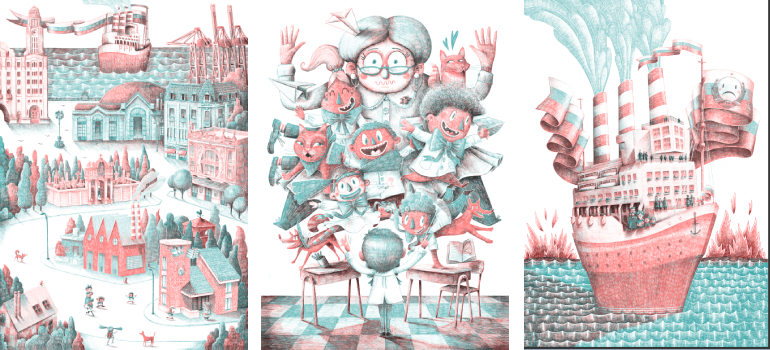- Home
- About us
- News
- Events
- EXPORT Export
-
BUY
Buy
Buy
- INVEST Invest
- COUNTRY BRAND Country Brand
-
INFORMATION CENTER
Information center
InformationCenterInformationCenterReports Country reports Department reports Foreign trade reports Product-Destination worksheet Sectors reports Work documentsStatistical information Classification Uruguay XXI Exports Imports Innovative National Effort Macroeconomic Monitor Tools Buyers Exporters Investors
- Contact
-
Languages
Uruguayan illustration, a trendy art in the international market
With color and creativity, Uruguayan illustrators are positioning the country in the global children's book market.
Share:

With color and creativity, Uruguayan illustrators are positioning the small South American country in the global market for children's and young adults' books. A sector where stories are empty without painted images, and where Uruguay is succeeding, especially in Europe and Asia.
"A picture is worth a thousand words," says a popular saying shared by members of the Uruguayan illustration industry, which works to export strokes of "exquisite" quality and technique, according to agent Jorge Varela, who represents 18 illustrators from this small South American country.
Drawing stories
A story of migrants, love, and football helped Uruguayan Eduardo Sganga win the 2019 National Illustration Prize and take his "Danube" project to the Bologna 2020 International Children's and Young People's Book Fair (BCBF), the largest showcase for this type of literature in the world.
Through reds and blues, Sganga expresses himself in the language of illustration, which has accompanied him since the first time he picked up a pencil when he was just a child.
"What is happening in Uruguay is a very rich process, at the level of training and exchange, which crystallized in recent years with a very interesting evolution by a number of artists who have been acknowledged abroad," says Varela.
Several publishers in Uruguay bet on the book album, in which the image has the same protagonism as the word and the illustration is fundamental.
"We are not only going with the trend of illustration but somehow generating a trend for the originality of Uruguayan illustrations," says the director of Basilisa Publishing, Mercedes Lafourcade.
In this way, and with a "language of its own", Uruguay is managing to "break the dynamic" and generate content for European and Asian markets, which were not used to buying Uruguayan culture, says the director of Amanuense, Rodolfo Bolaños.
Illustrate to include
A yellowish eye of a crocodile cries and looks at the reader of "Milo y Manú" in an illustration by the Uruguayan FABA that occupies the page of this book published by Basilisa, a publishing house that works for readers with dyslexia.
It is one of the "disturbing" images with which Basilisa fills her albums in order to "awaken" the child's interest in reading, says Lafourcade.
This publisher uses research in the field of cognitive science and artificial intelligence to create works adapted to and beneficial for people with dyslexia.
Thus, Basilisa plays with elements such as lexicon or typography to simplify the reading and to make the words have a cognitive effect on the audience, all with the help of the image, which never fails in quality.
"A book album is an object of great artistic value," says the publisher.
The Coronavirus, an opportunity for the book' s "rebirth"
Inevitably, the COVID-19 pandemic affects the publishing industry, which is itself "very sensitive," notes Bolaños.
However, since the children spend more time in their homes, this can be an opportunity for the picture book's "rebirth", points out Jorge Varela.
Although there is no mandatory quarantine in Uruguay, teleworking is encouraged, something that was already common in Edu Sganga's life, says the illustrator. This can also serve as a "trigger" for an illustrator's productive work, adds Varela.
Together with Amanuense and Basilisa, the two illustrators attended the Bologna Fair this year, thanks to the support of Uruguay XXI, the investment and export agency, and the Ministry of Education and Culture. For the first time, the event was held virtually, something that the Uruguayans were able to take advantage of.
"This new modality is positive. It makes the publishing industry more dynamic because it allows us to show our work all year round. It also enables us to incorporate new projects and new publications that we have to show to our customers and, in that sense, it is a tool that did not exist before", says Varela.
On a "virtual" wall, illustrators and publishers hang their works so that other markets know them and buy their rights to publish them in other countries and languages, as has happened with several Uruguayan artists.
These meetings also allow for an exchange of ideas, impressions, and trends between artists from different parts of the world.
"It was very nourishing. Something that was good for me was feeling that I was part of it, that I wasn't so far away," says Sganga about his participation in Bologna.
This way, approaching through the screen, Uruguayan talent will be able to continue painting their colorful stories for the rest of the world.
(EFE - Sergio Marín Lafuente)
